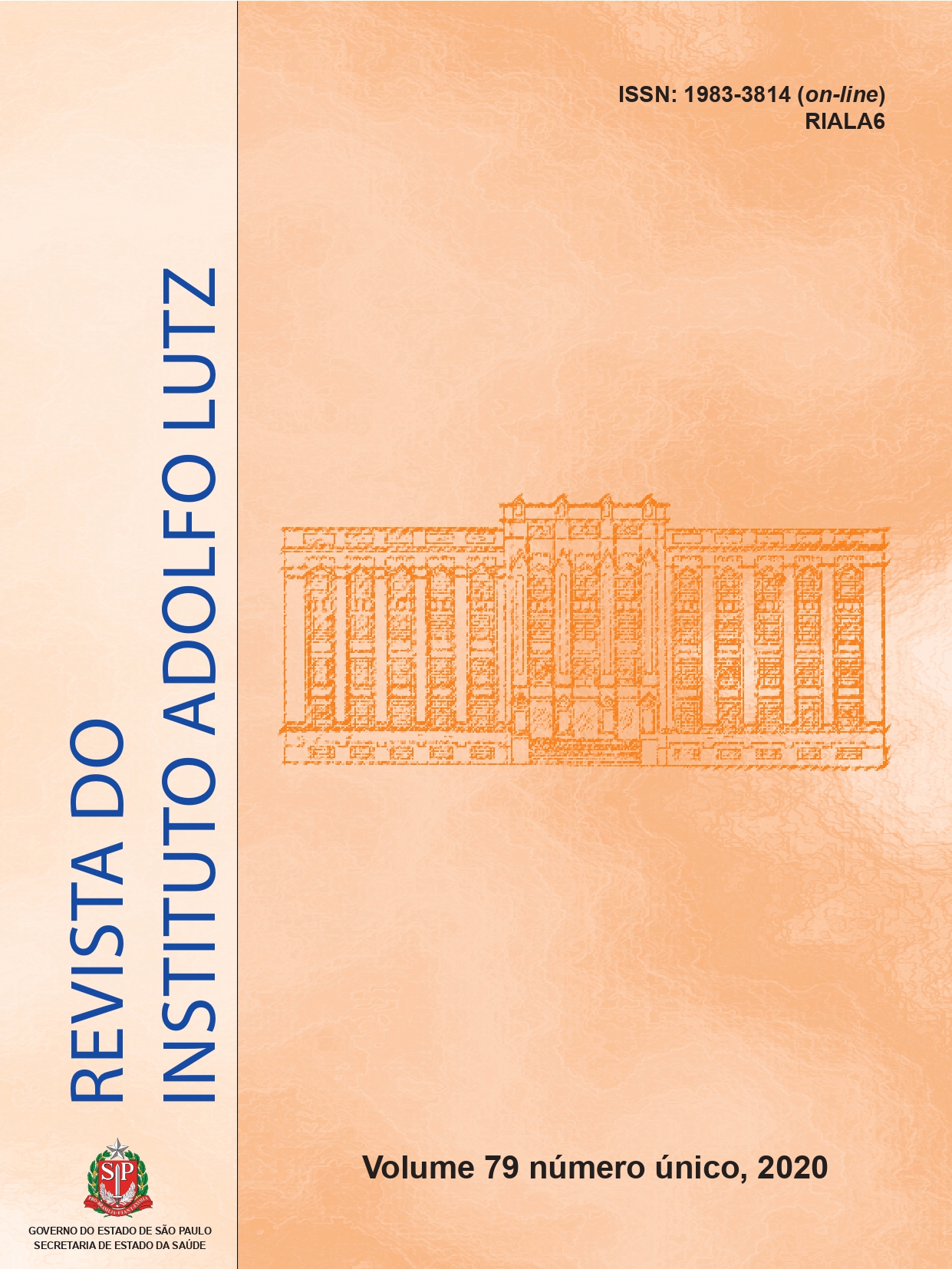Abstract
A reassessment was carried out on the preservation status of helminth eggs and protozoan cysts maintained for about 40 years in 0.2% potassium iodine-mercurate solution. It was observed that Schistosoma mansoni, Ancylostomidae and Trichiuris trichiura eggs and Isospora belli oocysts were kept in conditions suitable for their identification under a common light microscope. In the examined material, it was possible to verify the presence of miracidium in S. mansoni egg, larvae in T. trichiura egg and sporozoites in I. belli oocysts.
References
1. Aguiar PR, Ventura VR, Burkart IHV, Nascimento JA,
Lima IAR, Westphalen SR. Avaliação do biiodeto de
mercúrio como preservativo de material biológico. Rev
Inst Adolfo Lutz. 1981; 41(1):47-52. Disponível em:
http://www.ial.sp.gov.br/resources/insituto-adolfolutz/
publicacoes/rial/80/rial_41_1_1981/h522.pdf
2. Meyer KF, Johnstone HG. Laboratory Diagnosis of
Amebiasis. Am J Public Health Nations Health. 1935;
25(4):405-14. http://dx.doi.org/10.2105/ajph.25.4.405
3. Coutinho JO. Notas sobre modificações do “MIFC”
na conservação de fezes para pesquisa de cistos de
protozoários. Arq Fac Hig Saúde Púb Univ São Paulo.
1956; 10(1/2):65-70.
4. Junod C. Technique coprologique nouvelle
essentiellement destinée a la concentration des
trophozoites d’amibes. Bull Soc Pathol Exot. 1972;
65(3):390-8.
5. Amato Neto V, Corrêa LL. Exame parasitológico de
fezes. 4.ed. São Paulo (SP): Sarvier; 1980.
6. Sapero JJ, Lawless DK. The MIF stain-preservation
technic for the identification of intestinal protozoa. Am
J Trop Med Hyg. 1953; 2(4):613-9. http://dx.doi.org/
10.4269/ajtmh.1953.2.613
7. Organização Mundial da Saúde - OMS. El mercurio y
la salud. [acesso 2020 Ago 15]. Disponível em: https://
www.who.int/es/news-room/fact-sheets/detail/
mercury-and-health
8. Organização Mundial da Saúde. Manual de segurança
biológica em laboratório. 3.ed. Genebra; 2004.
Disponível em: https://www.who.int/csr/resources/
publications/biosafety/BisLabManual3rdwebport.pdf
Lima IAR, Westphalen SR. Avaliação do biiodeto de
mercúrio como preservativo de material biológico. Rev
Inst Adolfo Lutz. 1981; 41(1):47-52. Disponível em:
http://www.ial.sp.gov.br/resources/insituto-adolfolutz/
publicacoes/rial/80/rial_41_1_1981/h522.pdf
2. Meyer KF, Johnstone HG. Laboratory Diagnosis of
Amebiasis. Am J Public Health Nations Health. 1935;
25(4):405-14. http://dx.doi.org/10.2105/ajph.25.4.405
3. Coutinho JO. Notas sobre modificações do “MIFC”
na conservação de fezes para pesquisa de cistos de
protozoários. Arq Fac Hig Saúde Púb Univ São Paulo.
1956; 10(1/2):65-70.
4. Junod C. Technique coprologique nouvelle
essentiellement destinée a la concentration des
trophozoites d’amibes. Bull Soc Pathol Exot. 1972;
65(3):390-8.
5. Amato Neto V, Corrêa LL. Exame parasitológico de
fezes. 4.ed. São Paulo (SP): Sarvier; 1980.
6. Sapero JJ, Lawless DK. The MIF stain-preservation
technic for the identification of intestinal protozoa. Am
J Trop Med Hyg. 1953; 2(4):613-9. http://dx.doi.org/
10.4269/ajtmh.1953.2.613
7. Organização Mundial da Saúde - OMS. El mercurio y
la salud. [acesso 2020 Ago 15]. Disponível em: https://
www.who.int/es/news-room/fact-sheets/detail/
mercury-and-health
8. Organização Mundial da Saúde. Manual de segurança
biológica em laboratório. 3.ed. Genebra; 2004.
Disponível em: https://www.who.int/csr/resources/
publications/biosafety/BisLabManual3rdwebport.pdf

This work is licensed under a Creative Commons Attribution 4.0 International License.
Copyright (c) 2020 Revista do Instituto Adolfo Lutz
Downloads
Download data is not yet available.
